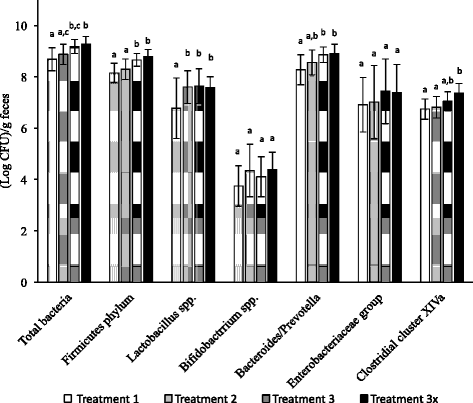Molecules produced by probiotics prevent enteric colibacillosis in pigs
- PMID: 29141637
- PMCID: PMC5688758
- DOI: 10.1186/s12917-017-1246-6
Molecules produced by probiotics prevent enteric colibacillosis in pigs
Abstract
Background: With the advent of antimicrobial resistance in animal pathogens, novel methods to combat infectious diseases are being sought. Among these, probiotics have been proposed as a means of promoting animal health but problems with their use has been reported. Research has demonstrated that bioactive molecules produced during the growth of certain probiotics interfere with bacterial cell-to-cell communication, which consequently results in an attenuation of virulence in a number of pathogens, including E. coli. The objective of this study was to determine the efficacy of the bioactive molecules, termed proteobiotics, produced by Lactobacillus acidophilus in preventing enterotoxigenic E, coli (ETEC) infection in pigs, which is the etiological agent for enteric colibacillosis, a common disease of nursing and young pigs.
Results: To achieve this, piglets were fed a preparation of the bioactive at four levels: 0, 0.5×, 1.0× and 2.0× for 7 days prior to challenge with E. coli K88. There were 36 pigs (18 gilts and 18 barrows) per treatment, resulting in 144 piglets in total for the study. Each pen had 6 piglets (3 gilts and 3 barrows). Only piglets with no physical abnormality or conditions were used in the trial and intact male piglets and ridglings were excluded. The bioactive continued to be fed to the pigs post-challenge. Based of fecal and demeanour scores, pigs fed the low and high dose of the proteobiotic were significanlty less likely to show symptoms of illness than pigs fed no bioactive. While not being significant, the weight gain of pigs given the proteobiotics was improved. At day 4 following challenge, almost 50% of piglets that did not receive the proteobiotic were shedding ETEC in their feces, compared with about 15% of animals receiving the supplement. There was also an indication that the proteobiotics reduced colonization of the ileum by E. coli K88 and improved gut health.
Conclusion: This study indicates that the bioactive molecules produced by L. acidophilus reduces incidence of enteric colibacillosis in pigs and their use on farms would help to reduce antibiotic use.
Keywords: Anti-virulence; Bioactive molecules; E. coli; Enteric colibacillosis; Pigs; Probiotics; Proteobiotics.
Conflict of interest statement
Ethics approval
The principles of CVM Guidance for Industry 85 “Good Clinical Practice” (VICH GL9).
May 9, 2001 were followed by Trouw Nutrition as described in protocol #ZS1424E. The study was approved by their Animal Care Committee.
Consent for publication
Not applicable
Competing interests
The bioactive compounds are being marketed by MicroSintesis Inc. At the time of the study RM was an employee of the company. Subsequent to this study MWG has accepted the position of Chief Scientific Officer of MicroSintesis Inc.
Publisher’s Note
Springer Nature remains neutral with regard to jurisdictional claims in published maps and institutional affiliations.
Figures

References
-
- Francis DH. Colibacillosis in pigs and its diagnosis. J Swine Health Prod. 1999;7(5):241–244.
-
- Paul N. Review: VIrulence nature of Escherichia coli in neonatal swine. Online J Anim Feed Res. 2015;5(6):169–174.
-
- Anon: Neonatal colibacillosis. In: The Pig Site. Nadis; 2009.
Publication types
MeSH terms
Grants and funding
LinkOut - more resources
Full Text Sources
Other Literature Sources
Medical
Molecular Biology Databases

